The name Tanzania conjures up images of wildebeest stampeding across vast savannah, rain forests teeming with monkeys and birdlife, and great plains brimming with legions of game. All of these natural wonders and more are on offer in this exceptionally diverse African nation. Visitors typically visit Tanzania to partake in at least one of the four well-known Tanzanian tourist experiences: a relaxing seaside vacation on the picturesque island paradise of Zanzibar, an underwater tour of some of the world’s most renowned dive sites around the gorgeous Spice Islands, a safari adventure in some of Africa’s most impressive game reserves, or a hiking excursion around Mount Kilimanjaro National Park. Whichever of these incredible holidays you choose, you will undoubtedly be welcomed by some fabulously friendly and peaceful inhabitants who, despite being divided into 120 different ethnic groups and cultures, live in harmony with one another and provide some of the most wonderfully exotic local cuisine you could imagine. With all of this diversity on offer, the most difficult part of your Tanzanian holiday experience is likely to be deciding where to go!
Arusha is the safari capital of Tanzania - nestled below Mt. Meru and close to Mount Kilimanjaro. From Arusha there are options to head to Lake Manyara, Tarangire and Ngorongoro National Parks and from there it’s a short trip to the Serengeti. Arusha was built by the Germans as a centre of colonial administration because of the temperate climate.

Tarangire National Park is known for having the greatest concentration of wildlife outside of the Serengeti eco-system. Named after the river that crosses through it, this park at 1,100 square miles located southwest of Arusha, is sometimes sadly missed by those heading for the more well known of the National Parks in Tanzania. Yet we can highly recommend it for its elephant migration, quiet authentic atmosphere and fantastic birding opportunities. During the dry season, the river is the only source of water for many animals, with thousands migrating to it from the nearby Lake Manyara National Park. The landscape here is diverse, with a mix of habitats that are unique to the area and not found anywhere else: hilly landscapes are dotted with vast numbers of baobab trees, dense bush and high grasses. Herds of up to 300 elephants congregate here, whilst migratory wildebeest, zebra, buffalo, impala and eland can also be seen, with the accompanying predators following along behind. On drier ground you find the Kori bustard, the heaviest flying bird; ostriches, the world's largest bird; and small parties of ground hornbills blustering like turkeys.
The park is also famous for the termite mounds that dot the landscape. Those that have been abandoned are often seen to be home to dwarf mongoose.
The swamps, an oasis of green year round, are where you will find over 550 bird species, the most breeding species in one habitat anywhere in the world. It is a birder's dream with frequent sightings of yellow-collared lovebirds, which can be seen during a game drive alongside the river.
Tarangire's pythons climb trees, as do its lions and leopards, lounging in the branches where the fruit of the sausage tree disguises the twitch of a tail.
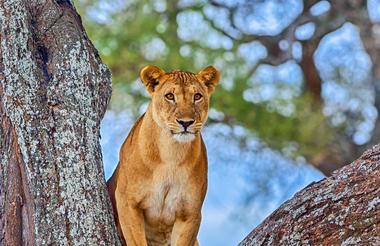
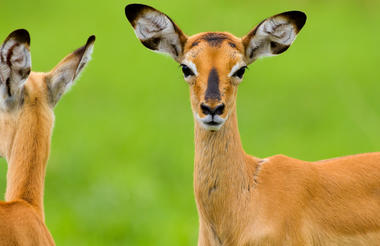
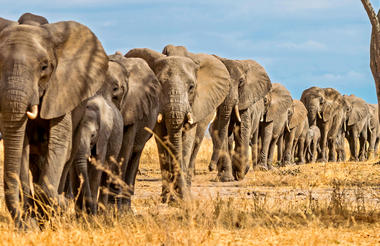
The Ngorongoro Crater, once a gigantic volcano, is the largest intact caldera in the world. Some maintain that before it erupted, it would have been higher than Mt Kilimanjaro, the highest peak in Africa. Today, long since having collapsed and eroded, it is an extensive highland area with the famous 600 meter deep Ngorongoro Crater as its focal point. Nearly three million years old, the ancient caldera shelters one of the most beautiful wildlife havens on earth. Fresh springs and a large soda lake quench the thirst of all the inhabitants.The Ngorongoro Crater is game viewing gone crazy and it is not surprising that it is one of Tanzania’s major tourist drawcards Black rhino are protected within its rim, giant tusked elephants wander the forests, black-maned lions stalk the grasslands, and flamingos crowd the soda lakes. It is also one of the view places where hyenas can be seen roaming during the daylight. Outside of the crater Masaai herdsmen can be seen tending to their flocks of goats and herds of cattle.
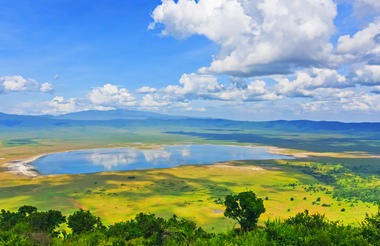
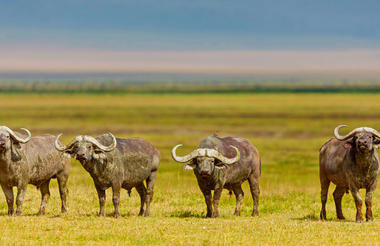
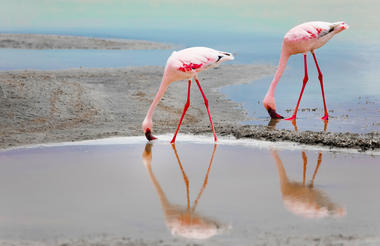
The Serengeti together with Kenya’s Masai Mara Game Park form Africa’s most famous wildlife park. The image of acacia trees on an endless grass plain epitomises Africa for many, and then add a Masai warrior and some cattle to the picture and the conversation need go no further. Unlike the southern plains of the Serengeti that dry out, forcing all but the hardiest of species to leave, the Northern Serengeti remains lush and green throughout the year. The annual wildebeest migration through the Serengeti and the Masai Mara is the largest mass movement of land mammals on the planet – with more than a million animals following the rains. From July through to October the Migration is in the Northern Serengeti and this is where many of the most famous scenes of the Migration occur with almost daily crossings of the Mara River. But that is not where the game viewing ends; large prides of lions, elephants and giraffes in grasslands, gazelles and eland to mention but a few.
NOTE: Animals are wild and sightings can not be guaranteed
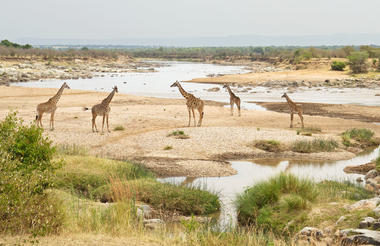
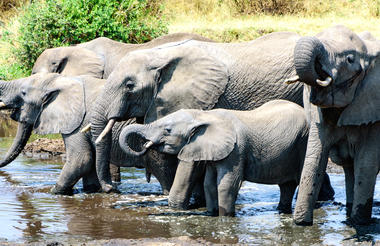
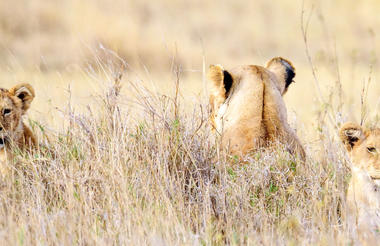
As previously described



Once referred to as the “Pearl of the British Empire in East Africa”, visiting Uganda, being one of the most beautiful countries on the African continent is like visiting the Garden of Eden. Uganda is a land of contrasts. In half a day you can drive from mist –shrouded volcanic mountains to hot, hazy savannah dappled with wildlife. Serene undulating lush hills of tea plantations give way to tangled jungle and rainforest with the musical accompaniment of chaotic, cacophonous birdlife. Uganda is alive with these contrasts: The tiniest sunbirds, iridescent in the morning light, the massive lumbering yet silent elephant, the chimpanzees crashing about the forest canopy, the majestic gorilla, chewing thoughtfully in the bamboo thicket. This is Africa the way it should be!
Ugandas biggest tourist draw are of course the mountain gorillas with almost half of the world’s population located in one of East Africa’s most famous national parks, the World Heritage listed Bwindi Impenetrable National Park. There is nothing in comparison to the thrill to observing these magnificent, peacefull apes in their native environment. But they aren’t the country’s only great apes. Humankind's closest relative, the chimpanzee, is found in several of areas of Uganda.
Parks with varied wild life covering different habitats, few tourists and friendly people make for a memorable experience well worth visiting. And as Uganda combines both Central African forests and East African savannahs , it is home to more than half of all Africa’s species of birds!
Located on the shores of Lake Victoria, Entebbe lies 40 km south of Kampala, Uganda's bustling capital. As the country’s primary gateway, it serves as both a peaceful retreat and a starting point for exploring Uganda's natural wonders. The city sits in a lush landscape, with sprawling green spaces and a shoreline dotted with fishing villages. The Entebbe Botanical Gardens, established in 1898, showcase a wide variety of plant species, from indigenous tropical forest to cultivated horticultural displays. The gardens are home to a diverse bird population, including the palm nut vulture and giant kingfisher, and provide a haven for primates like the black-and-white colobus. A short trip west leads to the Mabamba Swamp, a Ramsar Wetland, where visitors can explore by dugout canoe in search of the rare shoebill stork. Lake Victoria itself invites fishing, leisurely cruises, and excursions to Ngamba Island, a sanctuary for orphaned chimpanzees, where visitors can observe the chimps roaming freely across 40 hectares of forested land.
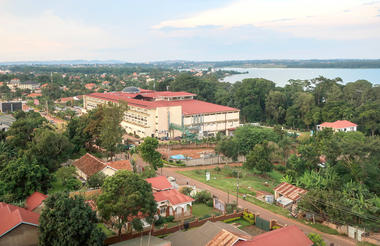
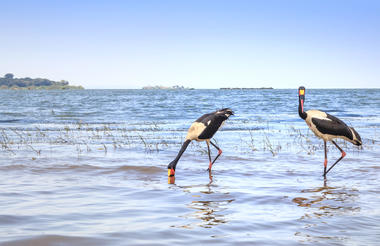
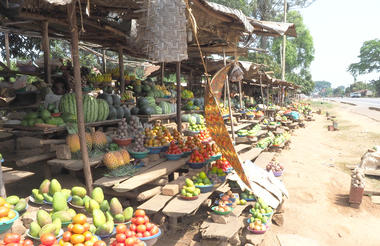
The Bwindi Impenetrable Forest is where you have the best chance of spotting a mountain gorilla family going about their business. Once you have your permit you are led across the rugged terrain and though the awe inspiring jungle to where the gorillas were seen the day previously and then you track them down. Aside from the amazing gorilla interactions there are numerous forest walks and 346 species of birds to track down, many of which are amazingly coloured.
Bwindi Impenetrable Forest is one of Africa’s most ancient habitat. With an altitude span of 3,800’ to 8,550’ this antiquity has produced an incredible diversity of flora and fauna, even by normal rainforest standards. And we do mean rainforest; up to 8.2 feet of rain falls here annually.






